#pharaoh primary
Explore tagged Tumblr posts
Text
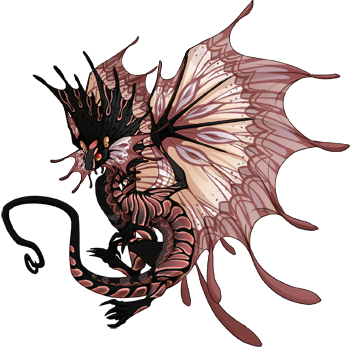
Fae Male
Coral / Cream / Brick , Pharaoh / Trail / Lace
#flight rising#flight rising dragon#flight rising scry#scrying workshop#fr scries#fr fae#flight rising fae#coral cream brick#pharaoh primary#trail secondary#lace tertiary#modern breed#ffrs best
55 notes
·
View notes
Text

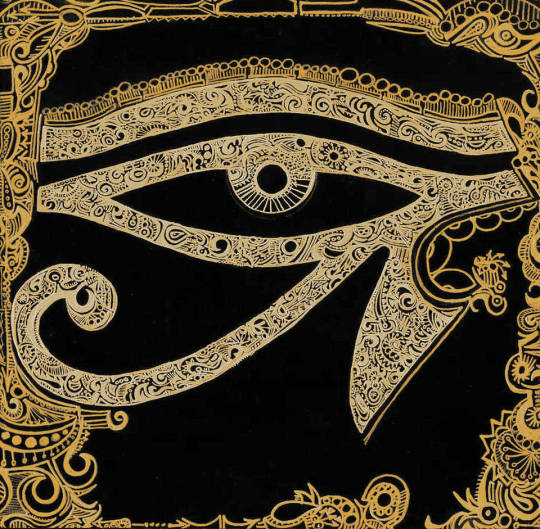
RA (Egyptian Sun God) Talon Abraxas
All the world knows that Nuu was called 'the one without eyes' and it was Ra, the Sun, who addressed him as "Thou oldest god, from whom I have arisen." Thus, out of that which sees not, the golden eye was born. And Ra said:
There were formed many forms, The forms of the forms in the forms of the children. What I ejected was Shu, What I spat out was Tefenet, My father, the abyss, sent them. My eye followed them through the ages of ages.
Ra (Re) was the primary name of the sun god of Ancient Egypt. He was often considered to be the King of the Gods and thus the patron of the pharaoh and one of the central gods of the Egyptian pantheon. He was also described as the creator of everything.
125 notes
·
View notes
Note
Nefretiti
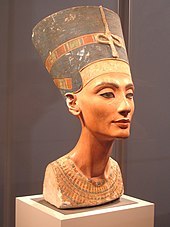
Neferneferuaten Nefertiti, or Nofretiti, (14th century BC; 18th dynasty, New Kingdom) is perhaps best well known for her bust, which has become world famous for its' uniqueness and craftsmanship. But Nefertiti played a role in one of the most controversial eras of Egyptian history. She is one of the most well-recorded Queens of ancient Egypt, but very little is known about her actual life besides conjecture.
Let's start with dissecting her name. Most people will divide her name up into the words Nefer and Titi; Nefer being a common word in ancient Egypt meaning beauty and goodness. In actuality, her name is divided up as neferet - iiti, more classically transliterated as Nfr.t-jy.tj. The t belongs to nefer as it is the denomination of a female pronoun in the ancient Egyptian language, and the jy.tj means coming or has come. All together, her name means The Beautiful One Has Come.
Nefertiti is indeed beautiful; she is, as mentioned earlier, one of the most depicted Queens of Egyptian history, with her image appearing on a great number of walls, in carvings and in paintings, and of course, statues. The reason for this is partly due to her marriage to the Heretic Pharaoh, Akhenaten. To understand this connection a little better, one must have some background about the Pharaoh Akhenaten.
Akhenaten and Nefertiti were married close to when Akhenaten was coronated, which was for him around the age of 16 or 18, and for Nefertiti was around the age of 12 to 16. Akhenaten is fairly well known Pharaoh. His controversial history has made sure of that, despite the fact that after he died, the following Pharaohs did everything in their power to rid Egypt of his memory by destroying his city and erasing all images of him. Akhenaten started off as Amenhotep IV––a name which connects him to the Egyptian God Amun, often associated with the sun, but representing hiddenness, and one of the highest and most powerful Gods of Egypt. The cult of Amun at the time of the New Kingdom was perhaps the most widespread cult of worship in Egypt, and the 18th dynasty, to which the Pharaoh Amenhotep IV belongs, is the first dynasty of the New Kingdom.
This was, apparently, unsatisfactory for the Pharaoh Amenhotep IV. Still, for the first 5 years of his reign, he followed Amun's cult, until he made a dramatic religious change to worship of the Aten; a new God that represented the sun disc. Aten was a faceless God, and the first mention of the word aten was in the Old Kingdom, and back then, it meant 'disc'. While Aten was worshipped as a mere aspect of Ra, the Sun God, in Amenhopte IV's father's (Amenhotep III) reign, Amenhotep IV decided that the Aten should be the primary deity worshipped. Amenhotep IV changed his name to Akhenaten, and worshipped the Aten above all else, as the nurturer of the world, the creator, and the giver of life. This would've likely been fine; however, Akhenaten decided that the Aten should be the only God worshipped, and banned the worship of all other Gods.
Ancient Egypt had been polytheistic since it's very earliest beginnings. Akhenaten essentially introduced monotheism out of nowhere and insisted all his subjects follow him in his new faith, outlawing all other worships, and forcing many priests to abandon the temples of other Gods. Additionally, ancient Egyptians were very accustomed to using an image to worship a God; the image usually being an animal, human, or an animal-headed human. But the Aten was a disc. Although the Aten had been worshipped in Amenhotep III's reign as a falcon-headed solar deity, Akhenaten insisted that the Aten be only shown as a disc with rays reaching out, with small hands on each ray.
Obviously, this caused a lot of dissent in Egypt and the following reigns.
Another interesting point of contention was the fashion in which the Aten interacted with the royal family. In the past, the Pharaoh was connected to the Gods more than any other human––he was the bridge between the two worlds, and the mediator between humanity and the Gods. This was, generally, not a task shared by the whole of the royal family. But in Atenism, the Aten would only shine its life-giving rays onto the Pharaoh and his royal wife; in this case, Akhenaten and Nefertiti. Thus the people, if they wanted to experience the life and love of the only, legally worshippable God, would have to go through the Pharaoh and his wife. This power would've likely, at least in part, been given to the royal family in order to cement their changes, and protect them from any backlash.
This massive change in culture and religion had great affects on ancient Egypt at the time. The style of ancient Egyptian art changed drastically, and the figures of the royal family were now represented as sinuous and gangly, often with large, sagging bellies and breasts, and curved, graceful facial features. Since Akhenaten and Nefertiti, as the royal family, were so important to this new religion of Atenism, the two of them were depicted in a number of scenes––many of them unique to the Amarna period, which is the name for the period in which Atenism was installed. These scenes were familial in nature; depicting the royal couple sitting with their children and bathing in Aten's life-light, throwing gifts down to the people, and engaging with one another. This is one of the main reasons that Nefertiti is the most widely-depicted Queen of Egypt. Not only is she depicted often as the wife of Akhenaten, but she is drawn in her own right––she makes offerings to the Aten on her own, and there are depictions of her smiting the enemies of Egypt, which is a role traditionally given solely to the Pharaoh.
Another piece of evidence for the high status of Nefertiti comes from this famous depiction of the royal Amarna family:

Here, Nefertiti sits on the right side, opposite her husband, Akhenaten. Akhenaten is holding up one of his children, and Nefertiti holds another two children; three of the six daughters that Nefertiti would bear for Akhenaten. The children are depicted in an almost grotesque, alien fashion, though it's not something you can really fault the artists for; it took a long time for artists across the world to realize that babies are not, in fact, just tiny humans, and that their proportions are different. Still, the style of the Amarna period is not helpful; with their large, oval heads, thin limbs, and sagging stomachs, it is difficult to imagine that anyone could be traditionally, Egyptian beautiful. Yet there is still a strange beauty to it; the sagging bellies are meant to call to mind Hapi, a God of great fertility, and the artist's ability to capture the facial features and emotions of their subject is amplified by this new and forgiving artstyle.
This image is a house altar. What that means is that people were encouraged, and evidentially did, worship the royal family in their homes, which is somewhat unprecedented. House altars were usually for Gods such as Tawaret and Bes, who were protectors of the household. But now, with traditional Egyptian religion banned, the typical house altar was now a shrine to Akhenaten and Nefertiti, and by extension, their children, which again shows the importance and power bestowed upon not just the Pharaoh, but his wife as well, as the two are represented in equal size.
Another interesting note about this particular house altar is the thrones on which Akhenaten and Nefertiti are seated. While Akhenaten's seat is mostly blank, Nefertiti is seated upon a throne reserved only for Pharaohs, the reason for this being the decorations which depict the Sema-Tawy ritual; the conjoining of the two lands.
Some time during the course of Akhenaten's reign, he decided to move the capital of Egypt to a deserted stretch of land along the Nile Valley, and called the new city Amarna, for which the period was named after. Here, the royal family took up residence, and this is where the cult center of the Aten would carry out its worship. This is also where Akhenaten royally screwed up his duties in foreign diplomacy, but that is a story for another day.
Before moving to Amarna, Nefertiti had three daughters in Thebes, the previous capital, and three more daughters in Amarna. In order, her daughter's names were Meritaten, Meketaten, and Ankhesenpaaten; then in Amarna, Neferneferuaten Tasherit, Neferneferure, and the youngest, Setepenre. It was to a lesser wife of Akhenaten's that the famous boy Pharaoh Tutankhamun was born, and originally, his name was Tutankhaten.
During his reign, when concerning Nefertiti, Akhenaten placed special attention upon her and loved her dearly, which is why she was one of the most powerful Queens of Egypt. Akhenaten described her as "possessed of charm" and "sweet of love", that "one is happy to hear her voice," and that "contents the Aten with her sweet voice". The two husband and wife were rarely depicted separately, and Akhenaten gave Nefertiti the title of 'heiress', although she was not the daughter of a King. Instead, what many scholars believe Akhenaten meant by this, was that she was to be his successor.
After Akhenaten's death, two Pharaohs ruled for a short time before Tutankhamun took over, and one of those Pharaohs is believed to have possibly been Nefertiti under the name of Neferneferuaten, which means beautiful is the beauty of the Aten. It is still debated whether this was in fact Nefertiti, but given that Nefertiti had given herself the name Neferneferuaten far before Akhenaten's death, and the elvated status gifted by her husband, it seems somewhat likely.
In essence, due to the circumstances of her life and her husband, Nefertiti was elevated to a status that never came before or after her life. Women in ancient Egypt were awarded the same rights as a man, but the wife of the Pharaoh was never depicted as equal to the Pharaoh in such a fashion, as being Pharaoh meant being the intermediary between the heavenly and the earthly, and was a special accorded honour. Nefertiti, perhaps due in part to her charisma and beauty, was given a position equal to the Pharaoh, which never happened unless it was a woman who was becoming Pharaoh. As controversial as Akhenaten's reign was, he did love his wife greatly.
I want to share my opinion on this subject a little, which is essentially to say, that I don't like Akhenaten and I don't try to hide it. His worship of the Aten is alright, but it is the banning of all other worship which rests very uneasily in me. That being said, there is a good source which goes more into detail about Nefertiti, and it is very pro-Akhenaten and anti-ancient Egyptian religion, instead glorifying the monotheism of Atenism and such. Still, it is a valuable resource; Nefertiti and Cleopatra: Queen-monarchs of Ancient Egypt, by Julia Samson, and can be found on Internet Archive here.
138 notes
·
View notes
Text
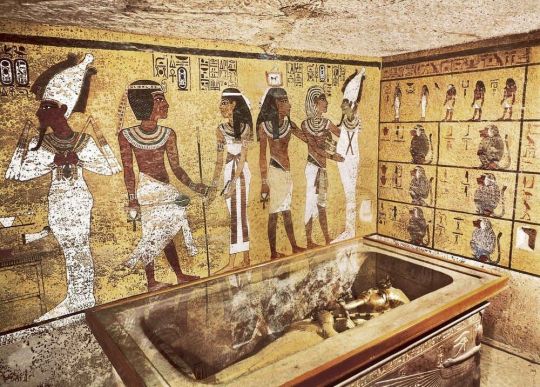
‘Curse’ Behind King Tutankhamun’s Tomb Mysterious Deaths Finally Solved
The unsettling curse of King Tutankhamun’s tomb in Egypt has bewildered archaeologists since it’s been feared to be linked to the mysterious deaths of multiple excavators who discovered it in 1922.
However, a scientist now claims to have solved the mysteries of the infamous “Pharaoh’s Curse” more than 100 years later.
Toxic levels of radiation emanating from uranium and poisonous waste are believed to have lingered inside the tomb since it was sealed over 3,000 years ago, Ross Fellowes wrote last month in the Journal of Scientific Exploration (JSE).
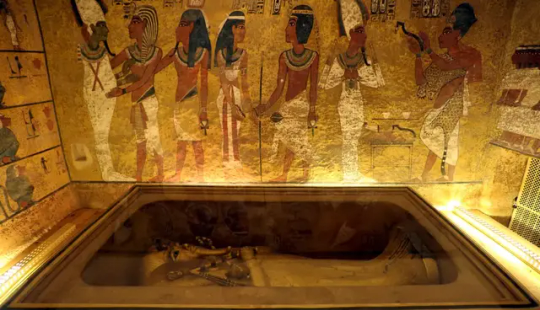
The burial chamber in the tomb of Tutankhamun, near Luxor, Egypt.
The radiation level inside Tutankhamun’s tomb is so high that anyone who comes in contact with it could very likely develop a fatal dose of radiation sickness and cancer.
“Both contemporary and ancient Egypt populations are characterized by unusually high incidences of hematopoietic cancers, of bone/blood/lymph, for which a primary known cause is radiation exposure,” Fellowes wrote in his study.
However, this radioactivity isn’t isolated to Tutankhamun’s tomb.
Fellowes revealed that “unusually high radiation levels have been documented in Old Kingdom tomb ruins” and spread throughout sites in Egypt.
“Radiation has been detected by the Geiger counter at two sites at Giza adjacent to the pyramids,” he wrote, adding that radon — a radioactive gas — has also been detected in “several underground tombs at Saqqara.”

The “Coffinette for the Viscera of Tutankhamun,” which contained the king’s mummified liver, depicts him as Osiris, holding a crook and flail.
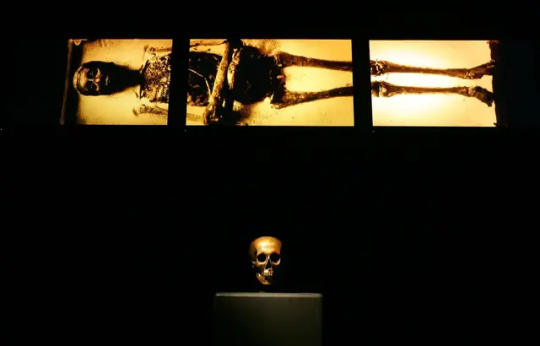
Medical imagery of Tutankhamun is shown above a replica of King Tut’s skull on display during the “Tutankhamun And The Golden Age Of The Pharaohs” at the Los Angeles County Museum of Art in California.
These readings were all found to be “intensely radioactive.”
“Modern studies confirm very high levels of radiation in ancient Egyptian tombs, in the order of 10x accepted safety standards,” the study shared.
It’s also theorized that those who built the ancient tombs were aware of the toxins based on the eerie warnings carved on the walls.
“The nature of the curse was explicitly inscribed on some tombs, with one translated presciently as, ‘they that break this tomb shall meet death by a disease that no doctor can diagnose,’” Fellowes wrote.
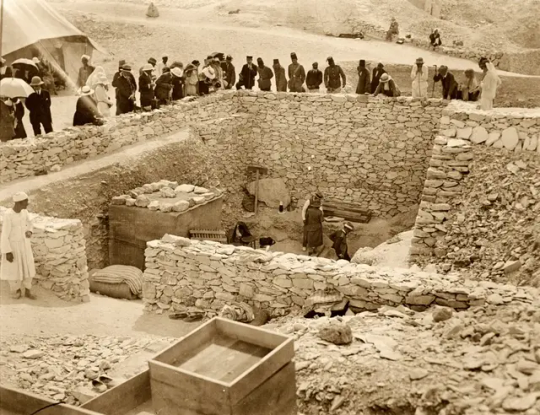
Outside the tomb of Tutankhamun during the 1922 excavation in the Valley of the Kings in Egypt.
Other ominous translations like “forbidden” because of “evil spirits” may have significantly fueled the fear that supernatural curses lingered in the ancient sites.
Those fears intensified with the mysterious deaths of Lord Carnarvon, who funded the excavation in 1922 and reportedly walked through the treasured filled rooms — and multiple others after they unsealed the tomb.
“Carnarvon was dead within a few weeks of the uncertain diagnosis of blood poisoning and pneumonia,” Fellowes wrote.
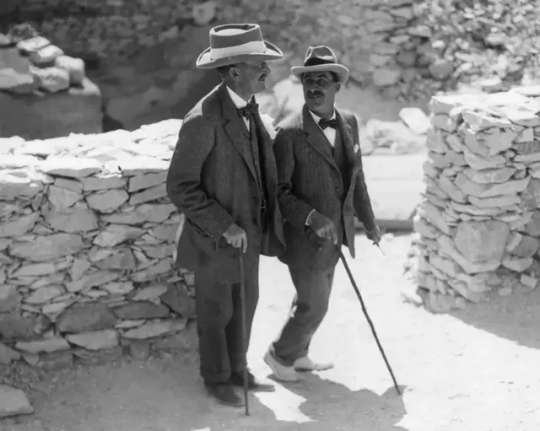
Egyptologist Howard Carter (R) walks with archaeologist Lord Carnarvon, the patron of his research, outside the tomb of King Tutankhamun in 1922.
Egyptologist Arthur Weigall allegedly told colleagues that Carnarvon would “be dead within six weeks” upon entering, the study claimed.
Howard Carter, the first person to walk inside Tutankhamun’s tomb with Carnarvon, died in 1939 after a long battle with Hodgkin’s lymphoma, which was suspected to be caused by radiation poisoning.
British Egyptologist and independent excavator Arthur Weigall was present at the opening of Tut’s Tomb and is also credited with starting the ‘myth’ of the curse.
He died of cancer at 54 years old in 1934.
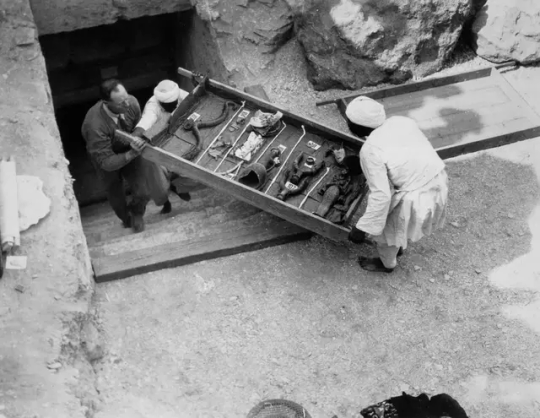
Workers remove a tray of chariot parts from the Tomb of Tutankhamun in the Valley of the Kings, Egypt, in 1922.
In total, six of the 26 people present when the tomb was opened died within a decade from asphyxia, stroke, diabetes, heart failure, pneumonia, poisoning, malaria and X-ray exposure.
While the deaths can be seen as odd, the curse theory was also likely fueled by the oddities that happened when it opened.
Carnarvon had reportedly suffered a mosquito bite that became severely infected.
Around the time excavators opened the tomb, Cairo reportedly suffered a bizarre power outage and a freak sandstorm, according to National Geographic.’
At one point during the excavation, Carnarvon’s favorite dog allegedly let out a chilling howl and suddenly dropped dead.

A photograph showing guards standing outside the tomb of Tutankhamun in Egypt in 1922.
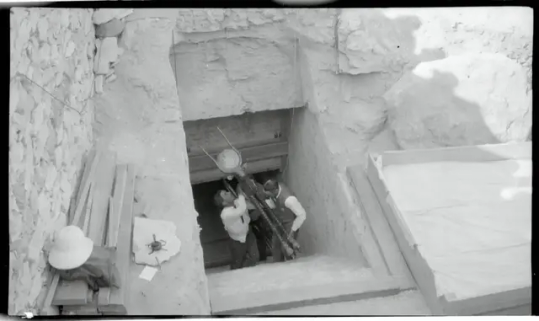
A sacred cow being removed from Tomb of Tutankhamun in 1922.
From a historical perspective, the discovery of the tomb in the Valley of Kings is considered one of the most fascinating finds that gave modern society a glimpse into the Egyptian royalty voyage into the afterlife.
Five thousand items, including solid gold funeral shoes, statues, games, and strange animals, were discovered inside Tutankhamun’s tombs.
It would take the excavators ten years to clear the tomb of its treasure.

The golden funerary mask of Tutankhamun.
The unsealing and studying of the tomb is also credited with launching the modern era of Egyptology.
Tutankhamun took the throne as pharaoh around nine or ten years old and ruled between 1332 BC and 1323 BC.
However, he died by the time he turned 18.
There are no surviving records of Tutankhamun’s death and how the young pharaoh died remains a mystery.
However, Tutankhamun is suspected to have suffered from several health issues — likely linked to his father, Akhenaten, and his mother, Nefertiti, being brother and sister.
By Richard Pollina.
#‘Curse’ Behind King Tutankhamun’s Tomb Mysterious Deaths Finally Solved#King Tutankhamun#Pharaoh’s Curse#Old Kingdom#Valley of the Kings#Lord Carnarvon#Howard Carter#Egyptology#ancient artifacts#archeology#archeolgst#history#history news#ancient history#ancient culture#ancient civilizations#ancient egypt#egyptian history#egyptian mythology#egyptian pharaoh#egyptian antiquities#egyptian art
78 notes
·
View notes
Note
You seem like you would have triple radiation dragons in your liar 🤔
PHEWWW I WISH I DID ‼️
If I had a triple radio, they'd probably look something like one of these scrys (i used pharaoh primary for the top 3 banescales)





32 notes
·
View notes
Photo

The History of the Ancient World: From the Earliest Accounts to the Fall of Rome
This comprehensive and engaging narrative covers many ancient civilizations, including Mesopotamia, Egypt, the Indus Valley, early China, Greece, and Rome. Bauer's accessible writing and use of primary sources make complex historical events understandable and interesting. Ideal for history enthusiasts and general readers, this book offers a balanced and detailed overview of ancient history.
The History of the Ancient World: From the Earliest Accounts to the Fall of Rome by Susan Wise Bauer is a sweeping and well-researched work that endeavours to present a coherent narrative of ancient history from its earliest beginnings to the fall of the Roman Empire. Bauer, a historian and seasoned author, undertakes the formidable task of chronicling the development of human civilisations across the globe, weaving together historical events, cultural evolutions, and significant personalities.
The book is organised into 70 chapters, each serving as a vignette illuminating specific eras, events, and figures in ancient history. Bauer's narrative is both chronological and thematic, a dual approach that allows readers to follow the progression of historical events while also understanding each period's broader cultural and societal developments.
Bauer begins her journey in Mesopotamia, exploring the rise and fall of ancient societies such as Sumer, Akkad, Babylon, and Assyria. She delves deeply into the development of writing with cuneiform, the establishment of legal codes exemplified by Hammurabi's Code, and the growth of urbanization and statecraft under rulers like Sargon of Akkad. Her detailed descriptions provide a vivid picture of how these early societies laid the groundwork for future civilisations.
The narrative then shifts to ancient Egypt, where Bauer traces the history from the early dynastic periods through the heights of the Old, Middle, and New Kingdoms. Her portrayal of Egyptian pharaohs such as Ramses II and Cleopatra pays particular attention to the complexities of their reigns. Bauer's exploration of Egyptian religion, monumental architecture like the pyramids and the temples at Karnak, and the daily life of its people enriches the reader's understanding of this ancient culture.
Bauer also examines the ancient civilizations of the Indus Valley and China. She discusses the sophisticated urban planning and social organization of the Harappan culture, as well as the early Chinese dynasties of Shang and Zhou, highlighting their contributions to writing, philosophy, and governance. Bauer's ability to interweave these diverse cultures into a single narrative thread is a testament to her skill as a historian and storyteller.
The book provides an in-depth look into ancient Greece and the Roman Republic and Empire. Bauer details impactful philosophers like Socrates, Plato, and Aristotle, military and political exploits executed by figures like Alexander the Great, the legacies of Julius Caesar and Constantine, and many other topics. Readers should pay attention to the discussion on the administrative and military structures that enabled Rome to maintain its dominance and its defining cultural and technological innovations. Bauer then concludes with the fall of Rome, marking the end of ancient history as traditionally defined and setting the stage for the medieval period.
Having published over six books, Bauer's writing style and storytelling skills to cover such a large timeline are evident, making complex concepts understandable and lively to a broad audience without sacrificing depth or accuracy. Her narrative is richly detailed while avoiding overwhelming readers with excessive minutiae. The book is well-supported by maps, timelines, and illustrations that contextualize the narrative and provide visual aids. Bauer's use of primary sources and quotations adds depth to her account, bringing the voices of ancient peoples into the modern narrative.
However, the book's scope also presents challenges. Some readers may find certain sections too brief, as Bauer moves quickly through some significant events and figures to maintain the narrative's momentum. Despite her efforts to include non-Western civilisations, the book still feels like it leans heavily towards a Eurocentric perspective, particularly in its treatment of the later chapters on Greece and Rome.
Overall, The History of the Ancient World is an impressive and highly readable account of ancient history. Susan Wise Bauer's synthesis of a vast array of historical data into a coherent narrative is commendable. While the book's scope means that some areas are covered more briefly than others, it remains an invaluable resource for anyone interested in the history of the ancient world.
Continue reading...
38 notes
·
View notes
Text
Mythology Olympics tournament round 1
Propaganda!


In ancient Egyptian mythology, Apophis was a malevolent deity or demon, often depicted as a giant serpent or snake. He was considered to be the embodiment of chaos, of destruction, and deep darkness. Ultimately, it was believed to be the primary enemy of the gods and the pharaoh. Since Apophis was seen as a constant threat to the order of the universe, his ultimate goal was to devour the sun god Ra and plunge the world into eternal darkness. He was often invoked in protective spells and incantations to ward off evil and ensure the continued prosperity of the kingdom.
Propaganda from the submitter:
He's just a lil' big worm boi
Flora is a Roman goddess of flowers and spring. She was one of the twelve deities of traditional Roman religion who had their own flamen, the Floralis, one of the flamines minores. Her association with spring gave her particular importance at the coming of springtime, as did her role as goddess of youth. She is one of several fertility goddesses and a relatively minor figure in Roman mythology. Her Greek counterpart is Chloris.
#Apophis#egyptian mythology#egyptian#egypt#ancient egypt#Flora#roman mythology#ancient rome#classical rome#roman#rome#tournament poll#polls#wikipedia#mythology#mythology tournament
28 notes
·
View notes
Text
While the debuting Boo York trio are all fun already, one of my favorite things about them is a dual motif they maybe-unintentionally share as a group: primary colors and states of time.
Mouscedes wears yellow, and is the daughter of an old fantasy/fairy tale character and wears an old-fashioned clothing style, making her emblematic of the past.
Luna wears red, and is the daughter of an enduring cryptid legend and has a modernist bold visual aesthetic, making her reflective of the present.
Elle is almost all blue, and very obviously represents the future with her speculative high-tech robot concept.
With the three viewed as a set of red/blue/yellow and past/present/future, it makes sense why the trio would be considered their own group apart from Pharaoh and Astranova, and I wonder just how deliberate it was.
#monster high#monster high g1#monster high boo york boo york#boo york boo york#elle eedee#mouscedes king#luna mothews#mothman#robot#nutcracker mouse king#fashion dolls#monsters
14 notes
·
View notes
Text





[In 2020 RS posted this interview with Harry and Niall for a 2012 cover story that never was (below) that was taken in April, so would have been a later issue than this, the band also supplied exclusive BTS photos to RS] RS also posted Simon’s. I wonder why this never ran.
HARRY STYLES AND NIALL HORAN: THE LOST INTERVIEW (x)
In a never-before-published 2012 interview, Harry Styles and Niall Horan talk about their childhoods, the future of One Direction, and much more
By BRIAN HIATT JULY 22, 2020

In the spring of 2012, I spent a few entertaining days hanging out with the five young members of a British boy band who were just breaking big in the United States. The guys from One Direction were unjaded, unguarded, totally charming, and a puppy pile of optimism and energy. On April 8th, in a New York City hotel room, Harry Styles and Niall Horan, both 18, sat down with me for a joint interview, published here for the first time. (The reporting was intended for a Rolling Stone cover story that never ran.)
It was late morning, and they had both just rolled out of bed. Styles wore a hotel bathrobe; Horan, with braces still on his teeth, was in sweatpants, a T-shirt, and a Dallas Mavericks hat a fan had given him during a recent trip to Texas. The conversation was casual, full of laughs, and focused on their formative years.
What did you do at the gym last night? Harry: One of our security guys, his friend’s over, he’s a personal trainer, so I was working with him, and he ripped me to shreds.
In 12 hours, you have to do Saturday Night Live. Are you ready? Harry: Yeah, I think so. I think it’s going to be a fun day. It’s just really exciting, obviously. The show is so huge. For us to get the opportunity to be on it at all was just amazing, and to us, to be performing and just be involved with the show is amazing.
Have you seen whole episodes of it? Harry: I’ve watched a lot of clips on YouTube. They don’t show it in the U.K.
Growing up, when did you realize you could sing or that you wanted to sing? Harry: I sang in primary school, like the school productions, plays and stuff.
What was your first one? Harry: The first one was … I was five, and there was a story about a mouse who lived in a church, and I was Barney, the mouse. I had to wear my sister’s tights, and a headband with ears on it, and I had to sing a song all by myself. I remember it was just like, whatever.… In the second, I was Buzz Lightyear in Chitty Chitty Bang Bang.So you know when they run and hide in the toy shop? Buzz Lightyear was in the toy shop, so they just created my character. The last one, I was in … you know Joseph and the Technicolor Dreamcoat? I was the pharaoh, but I was an Elvis pharaoh.
Did you have a sense that this is what you wanted to do in your life? Harry: I think in school I was OK, I wasn’t a bad student. I think I just knew I wanted to entertain people and stuff. I was a bit of an attention-seeker at school.
Niall: Me too. I just talked too much, sang too much.
You were onstage as a kid and were like, “This is what I like”? Harry: I knew it was fun, I had a lot of fun doing it, and I stopped when I started high school. And then I didn’t really do anything. I just sang at home, in the shower, in your bedroom, that type of thing. I guess it started again when my friends were in a band and they wanted to do this battle of the bands competition that was at school, and they needed a singer, and one of my friends asked me.
What did you sing? Harry: We sang “Are You Gonna Be My Girl,” by Jet, and “Summer of ’69.” We did it more towards the Bowling for Soup version.
How about you, Niall? Niall: I always knew I wanted to sing. I was academic.… I was one of those people that if I’m not interested in something, I don’t really care. If I’m not interested in school, I would have never trained or done my homework or anything, I’d have just gone outside and played football or whatever.
Harry: [Helpfully translating] Soccer.
Niall: So I always wanted to sing. I was singing here and there, not gigs or anything, but I always sang around the house or whatever, and I played Oliver in a school play. And then I just did that, and people told me I should do something … I was only 10, what could I do at 10? I just did a couple of gigs, and when I got to high school, they told me that I should just try out for The X-Factor.
Who told you? Niall: My French teacher. We used to do talent shows and stuff at school. She was like, “You should do it.” So I did it.
What did that entail? What were the steps from being a kid in high school to getting on the show? Niall: It was the final of The X-Factorthe year before, and at the end credits of the final, it says, “If you want to apply for 2010, go online.” So a couple of weeks later, I said, “Right, I’m going to do it,” and I filled in the form online. We were sending emails back and forth, going to this place, at this time. The first one is at a big stadium. Then, if you get through that, you come back the next day. Is that the way they did it with you?
Harry: I had to wait a little bit, I think.
Niall: I was there at 5 a.m., I got seen at 12, and I was out of there by quarter past 12. And the next day I came back at 10 in the morning. You get through the first round, then they do a round where they don’t tell you if you got through after that.
Harry: They film it.
Niall: The producer and someone from the label. They film it and show it to whoever. Then if you got through that, it takes about two or three weeks until you find out. I was in Spain. Then you just go through the audition.
Harry, how did you wind up on X-Factor? Harry: I basically said — the same as Niall, I was watching the year before, and I remember looking at the young guys on there — and I was kind of like, “I’d love to have a go at it just to see what happens,” and that was kind of it. My mum actually did the application. And then three weeks later, I walked upstairs and she said, “Oh, you’ve got your X-Factor audition Sunday,” and I was like, “OK.”
Niall: In England, it’s the biggest thing ever. It took a while to build.
Harry: The two or three years were steady, and third or fourth, it just blew up.
Niall: It works [out] that one in three people in the U.K. watch it. There’s 60 million people in the U.K., and 21 million people watched the final the year we were in it.
Harry, your band also played at least one wedding, right? Harry: Yeah. We actually said that we’d do the wedding gig, and …
Niall: You get paid for it?
Harry: Yeah. One hundred sixty quid, between all four of us. Forty quid each.… We said we’d do it, and then we found out it was the weekend coming up, and we hadn’t done anything for it. So we asked the bride what kind of stuff she wanted, and she said she didn’t mind, but she wanted some Bob Marley songs. Literally in three days, not even three, probably two days, we learned like 25 songs. We might have known like three of them before. I was 16, maybe 15, singing these Bob Marley songs. There was a girl a couple of years below us, and it was her mum. She said she wanted us to play.
Niall: Can you imagine you’re at a wedding and you have 16-year-old kids up on the stage?
Maybe you were really good! Harry: Yeah, the drummer is one of my best friends from school. He’s a sick drummer, he’s so good.
Did you think the band could be something? Harry: A bit. My friend’s mum was a radio presenter, and she did a radio show for a bit, so she was trying to sort us out a little bit of studio time. We were going to go in and record.
What do your parents do? Harry: My mum is a PA. My dad is a financial adviser.
How about you? Niall: My dad works at a supermarket, he’s the head manager, general manager of an area, not just one, and my mum is unemployed now, so I try to help them out whenever I can.
You probably can. That must be nice.Niall: Yeah, it’s nice, it’s good.
Plus, now you can tell them what to do.Harry: [Laughs] “Now you go to bed.”
Were you happy as kids? Did you have adolescent angst and stuff? Did you go through depressed periods?Harry: Not really. I think at one point, I started acting like I was … I had a phase of listening to really heavy music.
Niall: I never went through that.
Harry: Not stupid heavy, but a bit … just because I thought it was cool.
Like what? Harry: Like Nirvana T-shirts, wore black all the time, pretty much.
Were you pretty happy-go-lucky? Niall: Yeah, I was always happy. I think me and Harry were lucky. Our parents got divorced quite early, didn’t they, when we were really young. I was four. I didn’t know much, so I was always a happy kid, always up for a laugh, very carefree. And I’m a bit like that now.
Did you both grow up in your moms’ houses? Harry: Yeah.
Niall: I went between both. My mum moved to the country and I didn’t have any interest in it. I always felt like the country is for when you’re older. I was with my mom for a while but got bored. All my friends were in town, I went to school in town, and all that stuff. It was more like that.
Harry: I lived with both parents, and then moved with my mum, and we owned a pub for, like, five years. I remember the first night, it was like a night where a band was playing, and I just thought, “How am I going to get to sleep?” I was three stories up, I was like, “How am I going to get to sleep with this noise?” I was next to a road in Sussex, in the middle of nowhere, and by the end, I could fall asleep next to the band, I was so used to the noise.
Was it imprinting your brain? Harry: Maybe. One of the guys who used to play every so often, he used to be in Deep Purple or something … he started teaching me guitar when I was like 10 — I think 10, maybe nine. I loved it. I was 10, 11, all of the regulars, I got on with them. I’d walk behind the bar and my head would barely go over the bar. It’s still going now. We sold it to my best friend. We go in all the time still.
People say you come off as more mature than your age, you come off wiser. Did hanging around all those people as a kid help you mature?
Harry: I don’t know, maybe. I moved, when I was seven or eight, from Cheshire, and it was still Cheshire, but half an hour away. But in terms of not driving and stuff, all my friends lived near my school, so that was a bit further out. One of my friends there was my sister’s age — he was 16 when I was 10. It was so tiny, they were the only teenage boys.… We’d ride our bikes and go to the driving range and stuff. It was good, it was fun.
You both wanted to entertain. If it hadn’t worked out, would you have been really unhappy? Harry: Yeah, I think it would be kind of like … one of the reasons you go for X-Factor in the first place is that you want to do this, and it kind of helps you get out of the life that you were doing before. I worked in a bakery for two years. Obviously, I didn’t want to do that for ages!
If you’d asked people at school, would they have said, “Yeah, they’re probably going to be famous,” or would they never have guessed that? Niall: My aunt, I was in the back of her car. We used to go across Ireland to go to the beach for a couple of weeks, and I remember we were in the car, I was singing, and she thought I was the radio. And she told me — I never forgot it — that she thought I was going to be famous since I was six, seven. She was the only person who told me that, so I always remembered that.
Harry: My dad said it. I used to listen to a lot of the music he was playing. He’d play Elvis Presley to death, the Stones. I’d sing along to that and he’d say, “You’re going to be famous,” or whatever. He came on tour with us for a few days out here. He came to the Radio City show. He just said, for him, it was so educational. Obviously, he hears about what happens when I call him, but to see it and see it actually happen and how everything works was so good for him. He really enjoyed it, so that was nice.
So you grew up on Elvis and the Stones? Harry: Yeah, pretty much. My dad was a massive Stones fan, so it was pretty much Beatles and Stones in terms of what my dad played.
People say you kind of look like Mick. Niall: He gets that a lot.
Harry: I get it more here, probably, than I do at home. It’s because of the British thing.
What have you learned about life from the past few years? What didn’t you know? What advice would you give yourself?Niall: How much more independent we actually are — me, anyway. Your mum attends to your every need, and does your food and washing and gives you somewhere to live. Then you go into the real world, as you’re told as a kid …
Harry: We’re living on our own now.
Niall: We just started living on our own in the last six months, really.
Harry: I’m moving when I get back.
Niall: We do our own washing, we make our own food, we rent places, we’re out on our own now. You mature so quick. You’re dealing with big businessmen every day, you’re not dealing with school, people your own age. It’s a bit different.
Harry: You seem to learn so many life lessons, but in such a short space of time. If I speak to my friends and they’re having problems with girls, whatever it is, now I seem to just have the answer. I don’t know, it’s just different. Or I think I have the answer. In terms of … one of my friends was trying to decide what to do with school, stuff like that, and I would have had no idea what to say to him before.
The past two years must feel like 10. Harry: Yeah, but at the same time, it feels like six months. It’s weird: X-Factor was two years ago, but it seems like five years ago. But at the same time, it’s gone so quick. It’s a really strange dynamic of how it feels.
Do you have a sense of how this is going to go? Does it matter if it’s two years, five years, or forever? Harry: I think how much we all enjoy it, because we love what we do — if you have to call it a job, it’s an incredible job to have, and we love it. We’ll all want to do it for as long as possible. If we have the opportunity to have a Take That kind of career, I don’t see any reason why we wouldn’t want to do that. If we don’t, I don’t know.… We’ve done some amazing things already, but we don’t want to stop there, we want to keep going. I guess if we didn’t, I think we’d probably want to still be involved in … I’d just write, I guess.
Do you want to act? It feels like you could have your own TV show.Harry: I think it would be more of a documentary because, obviously, we’re not actors.
People must want you to try.Niall: Watch tonight, tell us what you think. Watch SNL.
Will you all make solo albums? Is that inevitable? Harry: No, I don’t think so.
Niall: Let’s do a swing album!
Harry: [Laughs] We’ll all do swing albums. We’re just so focused on this. We all feel so lucky just to be part of this opportunity that we’ve all been given. It’s incredible. We’re just loving it. It’s sick.
People make a lot of assumptions about people in your position. They think you’re puppets and do what you’re told. What do you do when people make those assumptions? Harry: When you look from the outside, especially if you’re a skeptic of groups made through TV shows, which is fair enough, people don’t see what we do on a daily basis, people don’t see … I think from the outside, it looks so glamorous — they see us do TV performances every now and again, see us doing an interview every now and again — but they don’t know that we work seven days a week.
Niall: If there was eight days, we’d fit it in.
Harry: It’s not as completely glamorous all the time — of course it’s not, [and] it would be stupid to think that it would be. But it’s hard work.
Niall: You’ve got to remember that you’ve got people on your team that have been doing this for many years and have been through the mill. You have all that experience around you, even from our tour manager, who’s been doing this for 20 years. They know what’s right. But at the same time, we want to have creative control, because at the end of the day, it’s us stepping out onto the stage of SNLtonight and have to sing these songs. We want to be singing what we enjoy, as we said last night. The music we all listen to is what we try and blend together to make this One Direction sound.
Harry: We obviously want to make it authentic and have our say without going, “People say we don’t control it, so we need to take control.” We’re not … we haven’t been writing songs for 20 years, we’re not producers. We’ve got an incredible team around us. Luckily, we’ve been given a lot of freedom, so we don’t go, “OK, we just need more and more control,” because we have a lot of control already. I think we find a really good balance in the way we work with our record label and our management, and it’s just how we work together, I think.
In any case, it’s probably better than the bakery. Harry: Yeah. But I don’t get a nice bun on my break anymore, that’s the thing.
Did you wear an apron? Harry: Oh, yeah, I wore a white polo shirt and a maroon apron with white stripes. “What would you like? 78 pence, thank you very much.”
Were you behind the counter? Harry: Yeah, I was behind the counter. It was good. It was Saturday morning. I started at five and finished at four in the afternoon, and got like 30 quid. It was a joke.
Niall, did you have a job? Niall: No, never.
So this is your first job. Niall: Yeah, not bad at all. I was chilling, I was being a kid.
Harry: I had a paper route before that. It gave me a bad back, bad posture. It was a heavy bag.
I interviewed some fans downstairs, and asked if they knew who you were six months ago, and they all said yes, and from a year ago.… They were all early adopters: heard you from the internet, watched X Factor on YouTube … Harry: It’s the internet. People have friends over here that might tell their friends and look on YouTube and show their friends. It’s insane how it’s blown up. We’ve had the opportunity to come over to America and do shows, and release our music over here, which is amazing. Through the power of social media, we already had a bit of a following before we’d ever been over here, we hadn’t done any shows. We had some fans out here, which was amazing but weird, really strange. I don’t know, it’s gone crazy. We don’t really see loads of it. We do the shows, then we’re in hotels, then we fly somewhere else. We don’t see massive amounts of it, we just go with it. This whole thing has gone on, and it’s sick.
Do you ever feel anxious through all of this? Harry: Yeah, I think, obviously, just naturally, you think about what’s going to happen in the future. We’re 18, 19, 20 years old. We’re young. I wouldn’t say anxious. We’re just excited most of the time and having so much fun, that if stuff were to finish and you were to look back on your time, and all you did the whole time throughout this amazing stuff was shitting yourself about what’s going to happen next, then it would just be … I think you have to enjoy it while it’s going on. I think you should be wary about the future, but not worrying about it all the time. We still enjoy it and have fun, but, obviously, you do think, “What am I going to be doing in 20 years, 30 years?” I’ll have kids by then.
Harry, I saw a tabloid with pictures of everyone smiling, and you were looking thoughtful. Do you get down sometimes? While everyone else is having fun, do you start drifting off? Harry: No, I think I’m naturally … not everyone is happy all of the time. I think you always have times when … like when you’ve just landed off a really long flight or miss home or something. They got a picture of me where I wasn’t smiling. I usually smile, but they got one where I wasn’t smiling and used that, and then said I wasn’t happy. They did that for a few days. That’s when we were in L.A. last time. It goes with the morbid voice.
Ringo would say, “It’s just me face.” Niall: [Quoting A Hard Day’s Night] “Who’s that little old man?”
Harry: “That’s Paul’s grandfather. He’s very clean.”
Sometimes you can drift off, that’s just your thing. Harry: [Laughs] I’m just soulful, man, I try.
Harry, do you mind when you’re singled out for attention? Harry: I don’t know. I don’t really … I don’t know. We’re a band. Everything we do is together. I don’t take much notice of it.
So you’re not the Justin. Harry: No.
Niall: J.C. was popular, too, wasn’t he?
It’s not like that for you guys. Harry: Not at all.
There was an imbalance in that group. Harry: I think we find it important that people get to know all of our individual personalities, because …
Niall: I think that’s what’s good about it: People see us as individuals as well as a band. We all have our own personality and we all give something to a band. Previous bands, they go around and can never explain themselves, they can explain the band. But as individuals, what we bring to the band and stuff …
Harry: We all know that we all have our roles, and we all know that without one of us, it wouldn’t work.
———-
from Simon’s;
Just to go back to the very beginning: These are all talented guys. But someone as charismatic and talented as Harry alone, how did he not get through as a solo act? It’s a good question. He did a great first audition, and then we have a second stage of the competition where we have to narrow the numbers down to 32 from, say, 200, and for whatever reason, all five of them screwed up a section of that particular part of the competition. With him, I think we put it down to his age, etc., and that’s why he didn’t go though, but, at the same time, as we said no to them, there was a part of me going, “We can’t lose them, we gotta do something with them.”
What do you remember about your initial reaction to Harry? I can remember everything about his first audition: What he said, what he was saying he did for a job. I liked him instantly, and I thought, “This kid’s got everything: he’s really confident, he’s got unbelievable charisma, and he’s a good singer.” He wasn’t a great singer on his first audition, but he was a good singer and everyone gravitated towards him. He was exactly what you’re looking for when you make one of these shows: memorable and a natural frontman.
#Rolling Stone#May#2012#Up All Night Era#Harry Styles#Fetus Era#Magazine Scans#USA Magazines#internet archive#One Direction#One Direction Magazine Scans#Liam Payne#Louis Tomlison#Zayn Malik#Niall Horan#1D#1D Magazines
7 notes
·
View notes
Text
Flight Rising Dragons
One of my daily tasks was to save a morphology and it led to fixing up my Everlux babies, cuz uh...

Black Pharaoh/Umber Sarcophagus/Gold Eclipse. Uncommon Eye.
That new gene is doing some work. I thought of going with Tiger primary, but it was impossible to find for a bookworm and I'm too impatient to wait for it to cycle into the Marketplace. Besides...

Wisteria Starmap/Mulberry Constellation/Wisteria Harp. Primal Eye.
Their babies in Foresee Progeny look amazing.
#Flight Rising#Everlux#genes#dragons#need to build up my gems again lol#Rift would also look amazing for that girl but
8 notes
·
View notes
Text

Banescale Female
Sunshine / Marigold / Saffron , Pharaoh / Trail / Monarch
Fire Primal
#flight rising#flight rising dragon#flight rising scry#scrying workshop#fr scries#flight rising banescale#fr banescale#sunshine marigold saffron#pharaoh primary#trail secondary#monarch tertiary#ancient breed#fire primal#fr fire#primal eyes
14 notes
·
View notes
Note
For an Arden ask or ficlet idea: animals? Pets? Is he a cat person or a dog person?
By a convenient twist, I have a snippet that didn't fit anywhere else, which I started to write about Arden's years in Minrathous, and which mentioned a dog! So I've finished it out.
_____
As Neve moved to rifle through the papers on the desk, Arden looked around the rooftop apartment.
“Stayed in a place like this myself when I was in Minrathous.”
“Up off the street, with a view?” Neve whistled. “Aren't you posh?”
“Yeah, well. Shared it with two other guys. We had to be out on different shifts, so we could take turns with the bed.”
“Ah.”
“Why not just share?” Harding asked. “Seems simpler.”
Arden laughed, but it sounded nervous.
“We did a few times. The guys decided it was a no-go.”
Neve hummed thoughtfully. “I detect a story in that laugh.”
“Not really.” Arden made himself busy lifting the wool mattress and checking for slits that might hide evidence. When he stood back up, Neve was still looking at him, eyes narrowed.
“Alright, look. I snuggle, okay? I had a dog as a kid, and she slept with me, and I guess…I don’t know, alright! But I snuggle in my sleep.”
Harding’s “awww” was genuine, but Neve’s was decidedly mocking.
“Well, isn’t that sweet?” Neve cooed. He grimaced at her pleased smirk.
“You had a dog? Oh, tell us about it!”
Arden took Lace’s change of topic gratefully.
“Big russet sight hound. Named Scylax. Loyal as could be.”
“You named your dog Puppy?” Neve laughed delightedly.
“In fairness, I was seven at the time.”
-------
I poked around for what seemed like an interesting Tevinter-ish dog big enough to snuggle with, and chose the Pharaoh Hound, national dog of Malta, and rabbit hunting dog:

Scylax is a Roman dog name taken from primary sources, and yes, it means "puppy". :D
10 notes
·
View notes
Text

RA (Egyptian Sun God) Talon Abraxas

Eye of RA Ra (Re) was the primary name of the sun god of Ancient Egypt. He was often considered to be the King of the Gods and thus the patron of the pharaoh and one of the central gods of the Egyptian pantheon. He was also described as the creator of everything.
204 notes
·
View notes
Text

You know what, fuck it *dragon-ifies your DRDT cast*
I've been thinking abt making a flight rising AU for a bit now, but I finally got around to getting some simple sketches down and finalizing my ideas for the main cast (excluding MonoTV and a certain unnamed student).
Text is just breed, eye type, genes, and gene colors, but it's kinda disorganized and hard to read even when clicking on it, so I'll list everything below the cut.
Teruko Breed: Mirror Eye type: Earth Rare Primary: Shamrock Savannah Secondary: Umber Noxtide Tertiary: Pistachio Ghost
Eden Breed: Tundra Eye type: Earth Uncommon Primary: Cottoncandy Fade Secondary: Raspberry Seraph Tertiary: White Underbelly
Xander Breed: Guardian Eye type: Fire Primal Primary: Tomato Falcon Secondary: Rust Morph Tertiary: Black Spines
Min Breed: Gaoler Eye type: Arcane Unusual Primary: Wisteria Shaggy Secondary: Wine Stripes Tertiary: Wine Wintercoat
David Breed: Skydancer Eye type: Light Uncommon Primary: Ice Falcon Secondary: Twilight Constellation Tertiary: Lemon Sparkle
Charles Breed: Imperial Eye type: Light Common Primary: Violet Savannah Secondary: Heather Stripes Tertiary: Storm Capsule
Nico Breed: Fae Eye type: Plague Bright Primary: Stonewash Jaguar Secondary: Midnight Stripes Tertiary: Midnight Points
Ace Breed: Wildclaw Eye type: Fire Rare Primary: Vermillion Skink Secondary: Berry Toxin Tertiary: White Underbelly
Levi Breed: Gaoler Eye type: Ice Unusual Primary: Plum Boa Secondary: Eggplant Blend Tertiary: Magenta Weathered
Whit Breed: Aether Eye type: Ice Uncommon Primary: Cottoncandy Cinder Secondary: Heather Blaze Tertiary: Cyan Monarch
Arturo Breed: Pearlcatcher Eye type: Ice Common Primary: Splash Iridescent Secondary: Robin Blend Tertiary: Aqua Points
Veronika Breed: Aberration Eye type: Plague Unusual Primary: Red Pharaoh Secondary: Red Weaver Tertiary: White Ghost
Arei Breed: Pearlcatcher Eye type: Water Bright Primary: Ultramarine Ribbon Secondary: Ultramarine Eel Tertiary: Cornflower Glimmer
J Breed: Nocturne Eye type: Lightning Common Primary: Azure Vipera Secondary: Phthalo Eel Tertiary: Mantis Thylacine
Rose Breed: Coatl Eye type: Earth Rare Primary: Rose Poison Secondary: Rose Toxin Tertiary: Iris Glimmer
Hu Breed: Skydancer Eye type: Nature Bright Primary: Fern Petals Secondary: Emerald Butterfly Tertiary: Turquoise Stained
(Worth noting: not all tert genes are visible in the image)
37 notes
·
View notes
Text

Origin of the Eye of Ra Ra (Re) was the primary name of the sun god of Ancient Egypt.
He was often considered to be the King of the Gods and thus the patron of the pharaoh and one of the central gods of the Egyptian pantheon. He was also described as the creator of everything.
Ra, the Sun God --Mahaboka

41 notes
·
View notes
Note
Nyarlethotep
Do it
Nyarlathotep - Day 101 (Request)
Race: Vile
Arcana: Tower
Alignment: Dark-Law
September 2nd, 2024

...Shit, something slipped through the cracks... uh, Frosty, make a note to get some new janitorial staff. I mean, I guess this makes for more content...? Whatever. Demons, demons, it's all so demoning...
Need you some help? I promise I can... just give me the reigns. I don't want you misrepresenting me, after all. Humans are too foolish to understand their ends and beginnings, and that some may be more than one.

... Y'know what, sure. Whatever. Welcome aboard, Nyarly- now let me talk about you, for fucks sake.
Fie, you're impatient.
For fucks sake- okay, Frosty, get the hose, and I'll do the entry. Ahem.
Something that sometimes SMT, but mostly Persona, does, is intertwine the mythological with the fantastical. While a lot of Personas are based primarily off of mythological characters or major historical figures (I.E Captain Kidd, Sakuya, Anat, or Izanagi,) quite a lot are actually based on contemporary modern fiction, with characters such as Arsene or Zorro. One of my favorite examples of this, though, has to be from Persona 2, with its main antagonist being a major character in none other than HP Lovecraft’s very own mythos, tying together the two major sources for demons and personas- Nyarlathotep, the crawling chaos.
The annals of cosmic horror that make up Lovecraft’s sprawling series have quite a lot of outer gods- beings that exist outside of our own reality- but next to Cthulhu, Nyarlathotep is easily the most iconic and recognizable of this pantheon. It is shown as an actively malicious force in the universe, and while serving under the blind idiot god Azathoth that dreams of the world, it’s not afraid to scare and mess with the inhabitants of said world.
Portrayed as a cunning manipulator in its primary source work, the self-titled Nyarlathotep, Nyarlathotep is shown gathering followers who slowly lose control over themselves and their minds, and as the story literally begins to fall apart as it goes on, the world begins to fall apart as well. Its presence degrades those who follow him, though it wins over hundreds of people through demonstrations of control with strange, glass instruments- even before that, though, it’d force those who approached it to bow, taking the form of a pharaoh.
Since then, it appears sporadically throughout several stories, almost always as a manipulative and explicitly antagonistic force, as opposed to the generally uncaring forms of most other figures in the mythos. Shown as narcissistic and cruel-
Come now, I only wish to help.
Shut up. Anyways, its villainous streak continues throughout many tales, being variously described as a cunning man who typically appears as a pharaoh, though one with oddly caucasian features, though it also tends to appear elsewhere in other forms, evidently being a shapeshifter. The manner in which Nyarlathotep interacts with humanity is somewhat unusual for an elder god, though many still prescribe it as an elder god.
Regardless, Nyarlathotep seems to represent the decline and loss of humanity, one possibly brought about by the commercial world, as it may even represent said commercialization if some interpretations are to be followed (see ‘Literary Copernicus’ linked above.) It’s rather hard to describe much more about Nyarlathotep, given how much of the horror of Lovecraft is built on the unknown, but it’s clearly far more than meets the eye- its role is unknown past that of a servant of Azathoth, and the way its only role is typically just to manipulate those it comes across brings up more questions than it does answers.
In terms of design, though, I’d say that the SMT II and Persona 2 designs are about the same, at least in my eyes- the SMT II design is far more recognizable, but the mixes of designs and focus on cosmic horror and tentacles in Persona 2’s designs are incredibly fitting, so it’s hard to pick a favorite. Still, I do find it interesting that its role in Persona 2’s story is incredibly similar to that of it in most Lovecraft stories, being, yet again, a manipulator.
18 notes
·
View notes